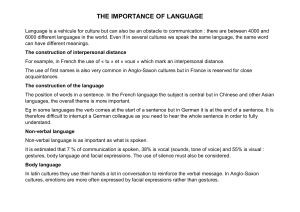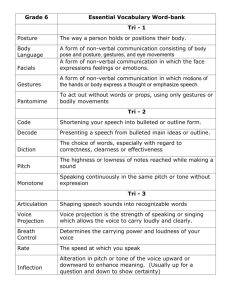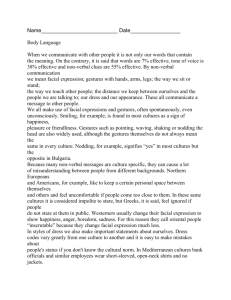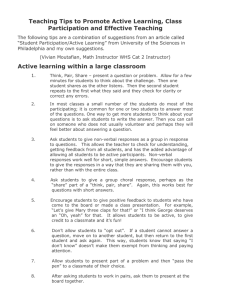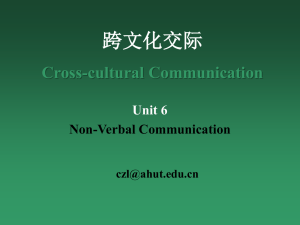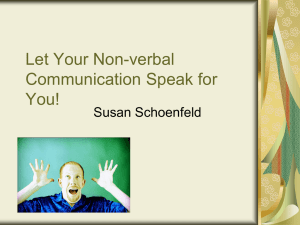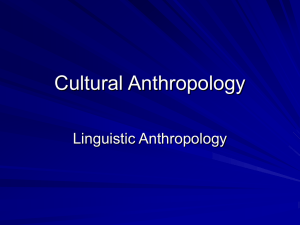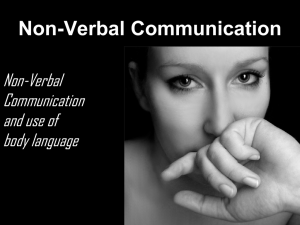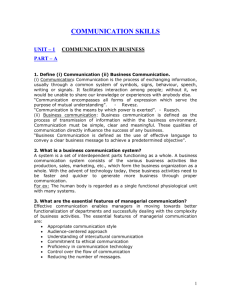Cultural Competency - Connecticut Youth Services Association
advertisement
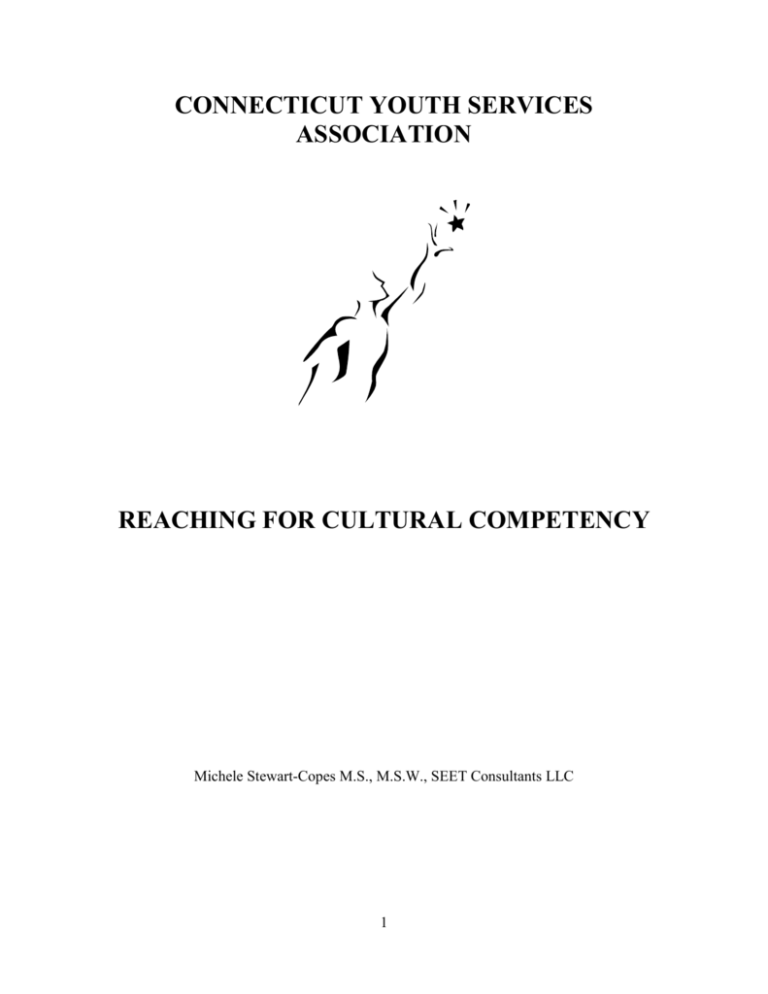
CONNECTICUT YOUTH SERVICES ASSOCIATION REACHING FOR CULTURAL COMPETENCY Michele Stewart-Copes M.S., M.S.W., SEET Consultants LLC 1 REACHING FOR CULTURAL COMPETENCY Cultural Competency refers to the ability of an individual or the capacity of an organization to respect and affirm cultural differences in order to serve diverse communities more effectively. There is a compelling need for cross cultural skills as organizations respond to demographic changes, work toward eliminating health disparities, improve the quality of human services and meet regulatory and accreditation mandates. This seminar will help individuals to be more comfortable and skilled in relating to people of different identity groups and will facilitate the formation of strong working teams. Participants will be better able to recognize diversity issues and will learn how to respond productively. METHODOLOGY Mini Lecture Large Group Brainstorm Role Play Small Group Experiential Exercises Personal Sharing of Views, Values & Expectations 2 REACHING FOR CULTURAL COMPETENCY SEMINAR OBJECTIVES Participants will build sensitivity, understanding of others and an appreciation for diversity. Participants will develop a knowledge base about how cultural values and assumptions influence relationships and interactions. Participants will develop self-awareness of cultural values and assumptions as well as communication strengths and challenges. Participants will become more aware of their own stereotypes and attitudes. Participants will develop communication skills to engage in meaningful dialogue about cultural influences. Participants will apply domains of knowledge with diverse populations in clinical, educational and social settings. 3 WHO’S IN THE ROOM? Introductory Exercise (WHIIFM) A Preceptor for cultural competence and diversity is always to survey “who’s in the room?” It should be consistently done when you’re working with families or when you want to assess how a group can operate or function. So who’s in the room? What kind of energy have you brought into this learning experience? What are your Needs & Expectations? What can you offer to this seminar? Name Background Story 4 ! PREAMBLE ! RESPECT Listen Actively Listen – Feelings Behind Words Understand Body Language Acknowledge Recognize Human Rights/Authority to be Represented Equally & Understood o (Disabled, Children, Elderly, Gay, Immigrants, Other Differences) Validate Officially, Intellectually Incorporate into your Personal & Professional Experience Give Legal Sanction - Create Policy 5 WHAT IS CULTURE? Culture is the total system of values, beliefs, attitudes, traditions and standards of behavior that regulates life in a group of people. Culture is comprised of: Ethnicity, Knowledge, Shared ideas and Meanings........... Rules, Customs, Law, Traditions, Rituals, Beliefs Diet, Dress, Body Image, Concept of Space and Time, Family Structure, Communication........................ Lifestyles, Behaviors, Perceptions, Emotions, Attitudes toward Health, Illness, Life Experiences Sub cultures- social groupings with sufficient distinguished behaviors All of the above are learned as we are born into or live in a society. Culture is not genetic/racial. References: Office of Minority Health www.omhrc.gov National Center for Cultural Competence: http://www11.georgetown.edu/research/gucchd/nccc/foundations/frameworks/html 6 CULTURAL CONTINUUMS Preference - Bias - Prejudice - Discrimination – Oppression Racism - Institutionalized Racism Coping - Self Awareness - Self Acceptance - Positive Change Color Blindness - Color Awareness Hostility - Recognition of Difference - Supporting Rights of Difference - Open Communication on Issues of Sexual Orientation 7 COMMUNICATING WITH DIVERSE CONSUMERS Non-verbal communication is a subtle form of communication that takes place in the initial 3 seconds after meeting someone for the first time and can continue through the entire interaction. Non-verbal communication can impact the success of communication more acutely than the spoken word. Our culturally informed unconscious framework evaluates gestures, appearance, body language, the face, and how space is used. Yet, we are rarely aware of how persons from other cultures perceive our non-verbal communication or the subtle cues we have used to assess others. Styles of Speech People vary greatly in the length of time between comment and response, the speed of their speech and their willingness to interrupt. Tolerate gaps between questions and answers, impatience can be seen as a sign of disrespect. Listen to the volume and speed of the patient’s speech as well as the content. Modify your own speech to more closely match that of the consumer to make them more comfortable. Rapid exchanges, and even interruptions, are a part of some conversational styles. Don’t be offended if no offense is intended when a consumer interrupts you. Stay aware of your own pattern of interruptions, especially if the patient is older than you are. Eye Contact The way people interpret various types of eye contact is tied to cultural background and life experience. Most Euro-Americans expect to look people directly in the eyes and interpret failure to do so as a sign of dishonesty or disrespect. For many other cultures direct gazing is considered rude or disrespectful. Never force a consumer to make eye contact with you. If a consumer seems uncomfortable with direct gazes, try sitting next to them instead of across from them. 8 Body Language Sociologists say that 80% of communication is non-verbal. The meaning of body language varies greatly by culture, social status, gender and age. Follow the consumer’s lead on physical distance and touching. If the consumer moves closer to you or touches you, you may do the same. However, stay sensitive to those who do not feel comfortable, and ask permission to touch them. Gestures can mean very different things to different people. Be very conservative in your own use of gestures and body language. Ask consumers about unknown gestures or reactions. Do not interpret a consumer’s feelings or level of pain just from facial expressions. The way that pain or fear is expressed is closely tied to a person’s cultural and personal background. Guiding Conversations English predisposes us to a direct communication style, however other languages and cultures differ. Initial greetings can set the tone for a visit. Many older people from traditional societies expect to be addressed more formally, no matter how long they have known you. If the consumer’s preference is not clear, ask how they would like to be addressed. Consumers from other language or cultural backgrounds may be less likely to ask questions and more likely to answer questions through narrative than direct responses. Facilitate consumer centered communication by asking open-ended questions whenever possible. Avoid questions that can be answered with “yes” or “no”. Research indicates that when consumers, regardless of cultural background, are asked, “Do you understand,” many will answer, “yes” even when they really do not understand. This tends to be more common in teens and older consumers. Steer the consumer back to the topic by asking a question that clearly demonstrates that you are listening. Some consumers can tell you more about themselves through story telling than by answering direct questions. Galanti,G. (1997). Caring for Patients from Different Cultures. University of Pennsylvania Press. Hall, E.T. 9 SEVEN SKILLS OF LEARNING CULTURAL AWARENESS Taken from Managing Cultural Differences by Phillip Harris & Robert Morgan 1. The capacity to communicate respect 2. The capacity to be nonjudgmental 3. The capacity to personalize knowledge and perceptions 4. The capacity to display empathy 5. The capacity for role flexibility 6. The capacity to demonstrate reciprocal concern 7. The capacity to tolerate ambiguity 10 Cultural Collision Outcomes Beginning Relationships Role Clarification Expectations Hidden Rules/ Inequity/ Sharing Information CULTURAL COLLISIONS Anger Withdrawal Termination Assimilation 11 Lowered Expectations 12
